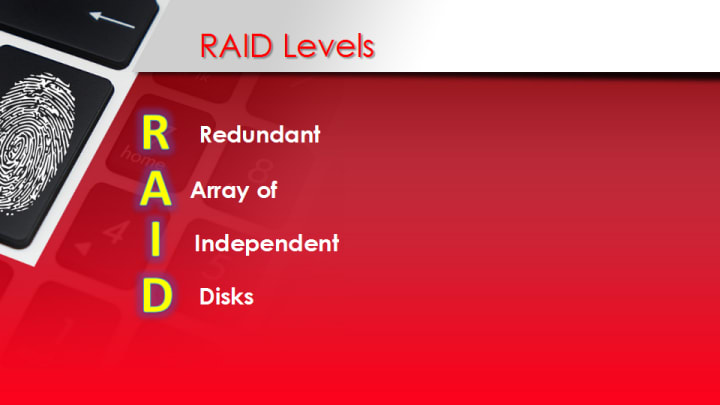Computer System Administration: Data Recovery and Backups
A report presentation for Computer Engineering (COE-620) - Computer System Administration.

Intended Learning Outcome (ILO)
At the end of the presentation, students should be able to:
- Identify the types of Backup
- Define RAID and classify the Levels
- Perform planning for Data Recovery
- Define the Disaster Recovery Plan
Activity-At-A-Glance
Scenario 1
Mr. Poblete, President of a trustworthy company, advised his MIS staff to do an auxiliary where all the files and folders selected for the backup will be backup. What method of backup Mr. Poblete wanted to?
- A. Differential Backup
- B. Incremental Backup
- C. Full Backup
Scenario 2
Mr. Lorico the Dean of the College of Engineering wanted to set up a backup job or task to be done every night from Monday to Friday. Assume Mr. Lorico performs his first backup on Monday. This first backup will be a full backup since he hasn't done any backups before this. On Tuesday, the ________________ backup will only backup the files that have changed since Monday and any files added to the backup folders. On Wednesday, the files changed and files added since Monday's full backup will be copied again. While Wednesday's backup does not include the files from the first full backup, it still contains the files backed up on Tuesday. What kind of back up did Mr. Lorico set up?
- A. Incremental Backup
- B. Differential Backup
- C. Full Backup
Scenario 3
Ms. Asis the General Manager of Imperial Networking Academy decided to set up a backup job or task to be done every night from Monday to Friday. Assume that Ms. Asis backup will be a full backup since she hasn't done any backups prior to this. On Tuesday, the _____________________ backup will only backup the files that have changed since Monday and any new files added to the backup folders. On Wednesday only the changes and new files since Tuesdays backup will be copied. The cycle continues this way. What setup did Ms. Asis implement?
- A. Incremental Backup
- B. Full Backup
- C. Differential Backup
Introduction
You have heard horror stories of companies going out of business due to data loss. You have also heard that the data loss could have been prevented by backing up the data. Typically, there are three ways: Full Backup, Incremental Backup, and Differential Backup.

Types of Backup
- Full Backup
- Incremental Backup
- Differential Backup
Other Types of Backup
- Mirror Backup
- Full PC Backup or Full Computer Backup
- Local Backup
- Offsite Backup
- Online Backup
- Remote Backup
- Cloud Backup
- FTP Backup
Answer to the Scenario 1
Scenario 1
Mr. Poblete, President of a trustworthy company, advised his MIS staff to do an auxiliary where all the files and folders selected for the backup will be backup. What method of backup Mr. Poblete wanted to?
- A. Differential Backup
- B. Incremental Backup
- C. Full Backup
Full Backup
A full backup is a method of backup where all the files and folders selected for the backup will be backed up. It is normally used as a preliminary or first backup accompanied by subsequent incremental or differential backups. After numerous incremental or differential backups, it is commonplace to begin over with a fresh complete backup again.
The maximum simple and complete type of backup operation is a full backup.
Advantages:
Fast and easy recovery as complete data is readily available. Files and folders are backed up to one backup set. Easy version control.
Disadvantages:
More storage space is needed. Additional bandwidth required. Time-consuming if full backup is run all the time.
Answer to the Scenario 3
Scenario 3
Ms. Asis the General Manager of Imperial Networking Academy decided to set up a backup job or task to be done every night from Monday to Friday. Assume that Ms. Asis backup will be a full backup since she hasn't done any backups prior to this. On Tuesday, the _____________________ backup will only backup the files that have changed since Monday and any new files added to the backup folders. On Wednesday only the changes and new files since Tuesdays backup will be copied. The cycle continues this way. What setup did Ms. Asis implement?
- A. Incremental Backup
- B. Full Backup
- C. Differential Backup
Incremental Backup
Incremental backup is a backup of all modifications made since the last backup. The final backup can be a full backup or truly the last incremental backup. With incremental backups, one full backup is achieved first and next backup runs are just the changed files and new files added since the last backup.
An incremental backup operation will result in copying only the statistics that has modified for the reason that the ultimate backup operation of any type.
Advantages:
Fast backup windows, as there is less data as compared to full backups. Less storage space (disk, tape, or network drive) needed . Allow retention of several versions of same files.
Disadvantages:
Slower recovery, as all increments must be restored. Initial full backup is needed before incremental backups start. A full backup and all incremental backups are needed for recovery . Takes longer to restore a specific file, as you need to search more than one backup set. If one of the backups fails (either the full or incremental), then recovery will be incomplete.
Answer to the Scenario 2
Scenario 2
Mr. Lorico the Dean of the College of Engineering wanted to set up a backup job or task to be done every night from Monday to Friday. Assume Mr. Lorico performs his first backup on Monday. This first backup will be a full backup since he hasn't done any backups before this. On Tuesday, the ________________ backup will only backup the files that have changed since Monday and any files added to the backup folders. On Wednesday, the files changed and files added since Monday's full backup will be copied again. While Wednesday's backup does not include the files from the first full backup, it still contains the files backed up on Tuesday. What kind of back up did Mr. Lorico set up?
- A. Incremental Backup
- B. Differential Backup
- C. Full Backup
Differential Backup
Differential backups fall within the center between full backups and incremental backup. A differential backup is a backup of all changes made since the last full backup. With differential backups, one full backup is carried out first and next backup runs are the changes made given that the last full backup. The result is a much faster backup then a full backup for each backup run. Storage area used is much less than a full backup however extra then with Incremental backups. Restores are slower than with a full backup but typically faster then with Incremental backups.
A differential backup operation is similar to an incremental the first time it is performed, in that it will copy all data changed from the previous backup. However, each time it's far run afterwards, it will continue to copy all data changed since the previous full backup.
Advantages:
Less storage space (disk, tape, or network drive) needed as compared to incremental. Only full backup and the last differential backup needed for restore. Allow retention of several versions of same files.
Disadvantages:
Slower backups than incremental backups. Initial full backup is needed before differential backups start. A full backup and all differential backups are needed for recovery. If one of the backups fails (either the full or differential), then recovery will be incomplete. Takes longer to restore a specific file, as you need to locate the file on differential or full backup sets.
Research predict that there are there will be 40ZB (zeta byte) of data on the planet in the year 2020.
RAID Levels

RAID - stands for Redundant Array of Independent Disks. RAID is a technique of taking a couple of physical disks and mixing them into a large virtual disk.
In computer storage, the standard RAID levels incorporate a simple set of RAID (redundant array of impartial disks) configurations that appoint the techniques of striping, mirroring, or parity to create large reliable data stores and their associated facts formats are standardized by way of the Storage Networking Industry Association (SNIA) inside the Common RAID Disk Drive Format (DDF) standardable data stores from multiple general-purpose computer hard disk drives (HDDs).
Types of RAID:
- RAID 0 – Striping
- RAID 1 – and its variants Mirroring
- RAID 5 – Distributed Parity
- RAID 6 – Dual Parity


Disaster Recovery
Disaster recovery outlines how a company: (a) Prepares for disaster , (b) Reacts to disaster , and (3) Recovers from disaster .
There are many different causes of disaster *natural disasters like - fire, a stolen laptop, power outages, a terrorist attack, etc. There are hundreds of disaster scenarios, and they are based on culture, geography, and industry).

Planning for Data Recovery
Roles must be assigned, rehearsed and revised. Know who is responsible . Have a plan of how to communicate (staff, customers, suppliers, and the like) . Write the plan (or update the plan) .
Conclusion
- Backing up is not a disaster plan
- Backups are just part of a larger disaster plan
- Backup only protects data
- Backups must be sent offsite
- 80% of companies close after data disaster
Full backups copy all sectors of the file image whether the sectors contain data or not. This is easy to operate; however, it is time-consuming, space-intensive, and the least flexible method. Incremental and differential backups are advanced strategies of backup that had been advanced to save time and disk space, as they both lower back up changed files only. Whether you pick out incremental or differential, make sure that your subsequent backups after the total backup do not grow to be being large than the overall backup. Keep in thoughts that the use of any method of backup is higher than having no backups at all. To prevent the data loss or data loss prevention. Use the RAID (Redundant Array of Independent Disks) .
About the Creator
Domingo Añasco-Gaces Samontina, Jr.
.Professional Member of the Mechatronics and Robotics Society of the Philippines
.Certified Documented Information Controller with TUV Rheinland Qualifications
.Master of Science in Engineering (on-going) with Professional Teacher Certificate






Comments
There are no comments for this story
Be the first to respond and start the conversation.